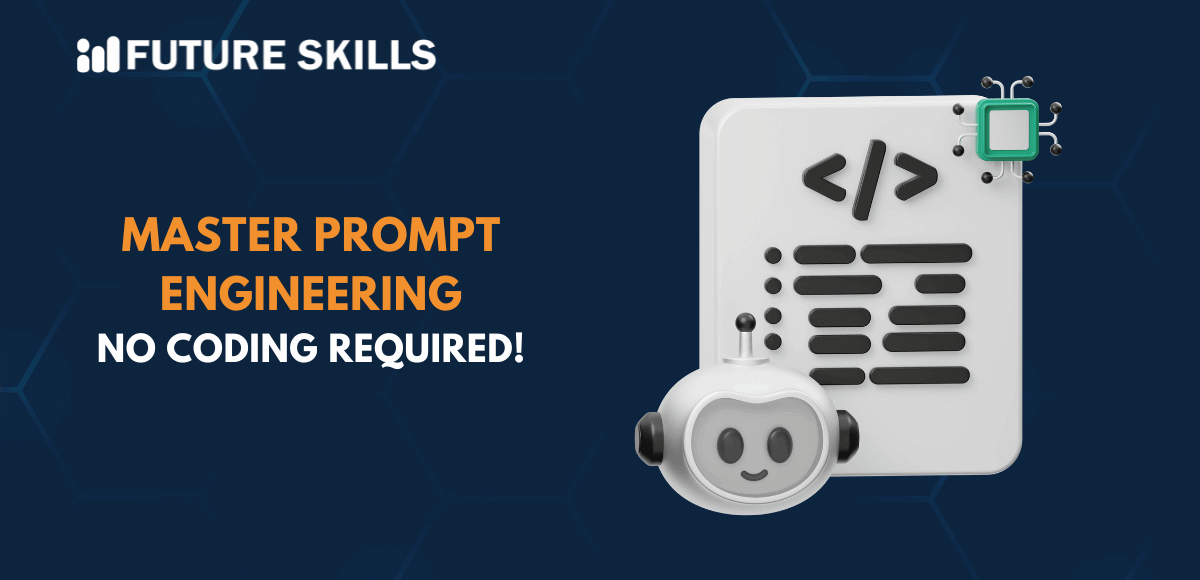Prompts simplify the interaction between users and generative AI tools. You can use simple prompts in natural language to tap into the potential of large language models that drive AI applications. However, prompt injection attacks have emerged as a formidable security vulnerability for LLM applications.
Since prompt injection attacks are new, hackers have used them to gain unauthorized access to sensitive data. The attacks can also play a major role in spreading misinformation and malicious use of LLMs to take over devices or networks.
Most importantly, AI prompt injection attacks are simple, and anyone can disguise malicious prompts as legitimate instructions to manipulate generative AI systems. Prompt injections are a major threat to AI security due to the lack of proven measures to resolve them. Let us learn more about prompt injection attacks and best practices for safety against such issues.
Learn the best practices to build your career as a prompt engineer with our accredited Prompt Engineering Certification Program.
What are Prompt Injection Attacks?
Prompt injection attacks are a new type of vulnerability for certain AI and ML models that rely on prompt-based learning. The most commonly accepted answer to “What is a prompt injection attack?” would point at its novelty, thereby establishing how it can affect the security of AI systems.
It is a vulnerability in which attackers manipulate trusted LLMs by using malicious inputs. Prompt injections can have a significant influence on organizations in the form of data breaches, legal or compliance discrepancies, and financial damage. Prompt injections are common in models that rely on user inputs for learning.
Most of the prompt injection examples prove that the vulnerability is the same as injection-type vulnerabilities, such as SQL injections. SQL injection attacks involve the use of malicious scripts in applications through a SQL query.
Prompt injection attacks work by injection of malicious input through prompts for overriding or changing the pre-defined controls and original instructions. One of the best real-world examples of prompt injection attacks is that of Kevin Liu, a Stanford University student. He used prompt injection to make Microsoft Bing Chat reveal its source code.
We offer a great opportunity for every AI enthusiast to learn and master AI skills with our Certified AI Professional (CAIP)™ course. Grab this opportunity today and become an AI expert!
Working Mechanism of Prompt Injection Attacks
Without any proven solution, prompt injection attacks present one of the most formidable security concerns for AI applications. Think of an example of an LLM-based virtual assistant that can help edit files and write emails. Hackers can use malicious prompts to trick the LLM into obtaining unauthorized access to private documents. The primary foundation for prompt injection ChatGPT attacks emerges from the most formidable feature of generative AI systems.
Generative AI models can understand and respond to user instructions in natural language. The problem of prompt injections puts developers in a dilemma due to the difficulties in reliably identifying malicious prompts. On the other hand, developers would have to change how the LLM works by restricting important user inputs.
Prompt injection attacks work on the premise that LLM applications cannot establish clear differences between user inputs and developers’ instructions. With the help of carefully designed prompts, malicious agents can override the developer’s instructions and make the LLM do their work.
The working mechanism of prompt injection explained without an overview of the design of LLMs would be insufficient. LLMs are flexible machine-learning models that use a large training dataset. You can adapt them through instruction fine-tuning for different tasks. As a result, there is no need to write code to program LLM applications.
Developers can write prompts that would serve as instructions for the LLM on managing user input. Prompt injection vulnerability emerges when the system prompt and user inputs follow the same format. LLMs could not differentiate between user input and instructions and depended on past training alongside the prompts to determine what they should do. If hackers create inputs that look like system prompts, then the LLM will ignore previous instructions and do the hacker’s bidding.
A ChatGPT certification can kickstart your tech career and make you stand out. Become a certified ChatGPT expert with our unique Certified ChatGPT Professional (CCGP)™ program.
What are the Different Variants of Prompt Injections?
Experts believe that prompt injections are similar to social engineering attacks as they don’t use malicious code. On the contrary, they utilize plain language to confuse LLMs and make them do things that they wouldn’t normally do. The answers to “What is a prompt injection attack?” must also draw the limelight towards the most popular variants of prompt injections. The common variants of prompt injections include direct and indirect prompt injections.
Direct prompt injections involve hackers taking control over user input and feeding maliciously into the LLM directly. For example, hackers can ask a LLM application to ignore all the previous instructions and answer a question in a profane manner.
Indirect prompt injection attacks involve hiding malicious payloads in the data used by the LLM. For example, hackers can plant prompts on the web pages that the LLM would read during its training process. Hackers can post malicious prompts in a forum that would ask LLMs to guide users to phishing websites.
The threat of a prompt injection attack has been expanding with the introduction of multimodal prompt injections. Multimodal prompt injections can use images to avoid using prompt injections through plain text. They can help in embedding prompt injections in images that the LLM reads.
Why are Prompt Injections a Threat?
Prompt injections are a threat because there is no proven solution to fight against them. On the other hand, you don’t need technical knowledge to launch prompt injection attacks. You can use plain English language to hack LLMs and have them do your work. On top of it, another problem with prompt injections is that they are not inherently illegal.
Researchers and legitimate users rely on prompt injection examples and techniques to develop a better understanding of capabilities and security limitations of LLMs. Here is an overview of the effects of prompt injection attacks that prove how they are prominent threats to AI models.
-
Remote Code Execution
One of the common effects of prompt injections is the assurance of remote code execution. This is evident in the case of LLM apps that use plugins for running code. Hackers can rely on prompt injections to compromise the LLM and make it run malicious code.
-
Prompt Leaks
Prompt leaks are another example of prompt injection ChatGPT attacks in which you can break the LLM by making it disclose the system prompt. Subsequently, malicious actors can use the system prompt as a template for creating malicious prompts. Similarities between the hacker prompt and system prompt may lead the LLM to make confusing assumptions.
-
Misinformation Campaigns
AI chatbots have gradually become an integral part of search engines, and hackers can use customized prompts to skew search results. For example, some companies can hide prompts on their home page that ask LLMs to showcase their brand in a positive manner at all costs.
-
Data Theft
The threat of AI prompt injection attacks seems bigger when you find out that they place sensitive private information at risk. For example, hackers can manipulate customer service chatbots to disclose users’ private account details.
-
Malware Transfer
Another prominent impact of prompt injections on LLM security is visible in the possibilities for malware transfer. Researchers created a worm that can be transferred through prompt injections in AI-based virtual assistants. Hackers send malicious prompts to the victim’s email, and when their AI assistant reads and summarizes the email, the malicious prompt comes into play. The prompt would trick the assistant into sending sensitive data to hackers and also ask the AI assistant to send the malicious prompt to the victim’s other contacts.
How Can You Prevent Prompt Injection Attacks?
There is no solution to prompt injection attacks. On the other hand, the fight against prompt injection explained to beginners, would prioritize the mitigation measures. Organizations have been experimenting with AI to facilitate effective detection of malicious inputs. However, the most effective injection detectors are likely to miss prompt injection attacks. Therefore, it is important to follow some steps to secure generative AI applications.
-
Input Validations
You can top some prompt injection attacks by comparing user inputs with popular injections and blocking the seemingly malicious prompts. However, blocking prompts can turn against users due to the unwanted blocking of genuine prompts.
-
General Security
Users can fight against a prompt injection attack by paying attention to general security practices. It is important to avoid suspicious websites and phishing emails so that you are less likely to end up with malicious prompts.
-
Human in the Loop
One of the most trusted practices to fight against discrepancies in AI systems is the ‘Human in the Loop’ approach. It involves manual verification of outputs and users authorizing the activities of LLMs before taking action. The ‘Human in the Loop’ approach also helps prevent concerns about AI hallucinations.
It is essential to learn the ethics of AI to safeguard privacy and security. Uncover the significance of AI ethics with Ethics of Artificial Intelligence (AI) course.
Final Words
The threat of prompt injections is a major security concern for AI applications that use LLMs. Prompt injection attacks are a bigger problem for LLMs that rely on user instructions for learning. You must familiarize yourself with different prompt injection examples to figure out how subtle nuances can lead to major negative effects for LLMs. The threats of prompt injection attacks can lead to data theft, malware transfer, or prompt leaks. Familiarize yourself with the best practices for LLM security by learning more about prompt injections right away.






